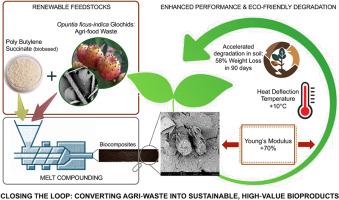可持续生物复合材料从聚丁二酸增强glochids:结合废物增值与改进的材料性能和加速生物降解性
IF 7.7
2区 材料科学
Q1 MATERIALS SCIENCE, COMPOSITES
引用次数: 0
摘要
本文研究了一种新型的可生物降解生物复合材料,该复合材料由聚丁二酸丁酯(PBS)和无花果果实纤维性食物废弃物glochids增强而成。glochids具有天然的倒刺表面,可以增强与聚合物基体的界面粘附性,有助于提高复合材料的性能。该研究符合循环经济原则,将丰富的副产品转化为功能性强化物,减少浪费,同时提供完全来自可再生资源的可持续材料,具有增强的性能。采用双螺杆挤压法制备了不同glochids负荷(14%、20%和30% wt%)的生物复合材料,并对其进行了全面的物理力学表征(热、红外光谱测量、形态分析、拉伸测试)和堆肥中的生物降解性分析。glochids的加入改善了机械性能,包括杨氏模量(在最大负载系统中最高可达约70%)和刚度的增加,热变形温度(HDT)的提高超过10°C,表明适合高温应用。此外,尽管glochids诱导了最初疏水性的增加,但堆肥掩埋测试表明,天然填料在90天内加速了降解,显示出改善的寿命终止性能。这些发现突出了PBS/glochids生物复合材料作为传统塑料的环保替代品的潜力,可用于包装、消费品和汽车内饰等应用。通过促进废物增值,这些材料符合循环经济的原则,促进更可持续的生产和消费实践。本文章由计算机程序翻译,如有差异,请以英文原文为准。

Sustainable biocomposites from polybutylene succinate reinforced with glochids: Combining waste valorization with improved material properties and accelerated biodegradability
This study presents the development and characterization of novel biodegradable biocomposites composed of polybutylene succinate (PBS) reinforced with glochids, a fibrous agro-food waste from Opuntia ficus-indica fruits. With their naturally barbed surface, glochids offer the potential to enhance interfacial adhesion with the polymer matrix, contributing to improved composite performance. The research aligns with circular economy principles by transforming an abundant byproduct into a functional reinforcement, reducing waste while providing sustainable materials entirely derived from renewable resources with enhanced properties. Biocomposites with different glochids loadings (14, 20, and 30 wt%) were prepared using twin-screw extrusion and subjected to comprehensive physical-mechanical characterization (thermal and FT-IR spectroscopy measurements, morphological analyses, tensile tests) and biodegradability analyses in compost. The addition of glochids resulted in improved mechanical properties, including increased Young's modulus (up to a maximum of ca. 70 % for the most loaded system) and stiffness, with an enhancement in heat deflection temperature (HDT) of over 10 °C, suggesting suitability for high-temperature applications. Moreover, despite the fact that glochids induced an initial increase in hydrophobicity, compost burial tests revealed that the natural filler accelerated degradation within 90 days, demonstrating improved end-of-life performance. These findings highlight the potential of PBS/glochids biocomposites as eco-friendly alternatives to conventional plastics for applications such as packaging, consumer goods, and automotive interiors. By promoting waste valorization, these materials align with the principles of a circular economy, fostering more sustainable production and consumption practices.
求助全文
通过发布文献求助,成功后即可免费获取论文全文。
去求助
来源期刊

Composites Communications
Materials Science-Ceramics and Composites
CiteScore
12.10
自引率
10.00%
发文量
340
审稿时长
36 days
期刊介绍:
Composites Communications (Compos. Commun.) is a peer-reviewed journal publishing short communications and letters on the latest advances in composites science and technology. With a rapid review and publication process, its goal is to disseminate new knowledge promptly within the composites community. The journal welcomes manuscripts presenting creative concepts and new findings in design, state-of-the-art approaches in processing, synthesis, characterization, and mechanics modeling. In addition to traditional fiber-/particulate-reinforced engineering composites, it encourages submissions on composites with exceptional physical, mechanical, and fracture properties, as well as those with unique functions and significant application potential. This includes biomimetic and bio-inspired composites for biomedical applications, functional nano-composites for thermal management and energy applications, and composites designed for extreme service environments.
 求助内容:
求助内容: 应助结果提醒方式:
应助结果提醒方式:


